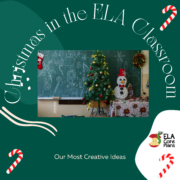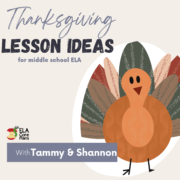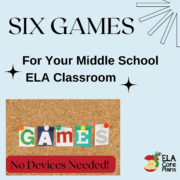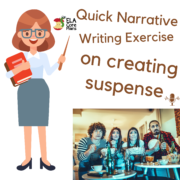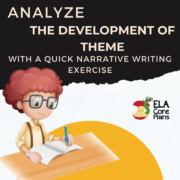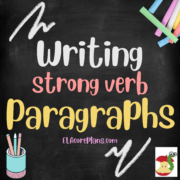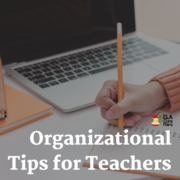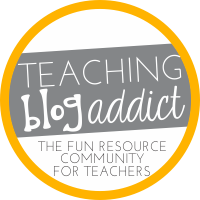Middle School ELA Christmas Activities
Add a little fun in your ELA class at Christmas time by reviewing important ELA skills and concepts. We do realize that everyone does not teach in a school or community like ours, so some of these ideas may not work for your students. Please be mindful of those students who may not celebrate Christmas. We hope, however, that you can use at least one of our middle school ELA Christmas activities this year!
Skits with a Twist!
Paper bag skits are a hit and can be used any time of year, but a Christmas spin can be put on these, and kids LOVE IT! Plus, it hits on the listening, speaking, and writing standards. You can do this in two ways.
- Place five random items in paper lunch bags. You will need a bag for each group of students that you have. Groups of four to six work best for this activity. For Christmas, make the items placed in the bag Christmas related. Think candy cane. Christmas ornament. Silver bell. Etc. Once the kids are in groups, give each group a bag. Each group can have the same items or different ones inside the bags.
- Instead of putting items in a bag, simply put pictures of the objects in the bag. This will save time and energy on your part. One group may have a picture of a candy cane, an elf, a grumpy looking man, a cabin covered in snow, and a cup of steaming hot chocolate. Another group can have a picture of the Grinch, a gift, a gingerbread girl, a sled, and a reindeer. The students take those pictures and write a skit to incorporate them. They will have to act with imaginary items, so they will have to be creative in their dialogue and actions so that everyone understands what the item is.
After all of the groups are finished writing their scripts, allow students to perform the skit for the class. You can require all students in the group to act or allow some of the more shy students the ability to walk through with signs or make sound effects “off stage”.
While writing, speaking, and listening skills are all covered extensively, this activity is also perfect to review elements of drama, like stage directions and asides because you can tell students what to be sure to include as they write their scripts. When students can effectively write an aside, they have a clear understanding of what one is and how they move a plot forward in a drama.
As the class watches the skits, have the students choose the best and most creative skit. This makes this activity one of the best middle school ELA Christmas activities because everyone is engaged in each part of the process.
Middle School ELA Christmas Trees
One of our most useful and standards based middle school ELA Christmas activities is to allow students to decorate the classroom with ELA Christmas trees. Using the large green bulletin board paper, cut out a large tree. Then, give students printable shapes of ornaments. Hold discussions about ELA terms. I have found that middle schoolers have brains like junk drawers when it comes to ELA concepts. Nothing is organized or categorized. If you ask, Give me an example of figurative language,” someone may shout out, “Adjective!” This is because everything is jumbled. Making different trees in your classroom can help your students categorize ELA terms and literary devices. Make a grammar tree. Make a figurative language tree. Make a story elements tree. You get the idea.
You can split your kids into groups and have each group be responsible for a tree.
You can also go a little deeper than categorizing terms and talk about how authors create things in stories. For example, you can have a tree focused on the development of theme and the ornaments that go there can list these – characters, setting, plot… You can have one on how authors create mood. Click here for a free printable that will give you ideas as well as printable ornaments for this project.
Analyze Figurative Language in the “Mr. Grinch” Song
The song “Mr. Grinch” is full of creative and hilarious metaphors and similes. First, have students listen to the song closely to listen for any similes or metaphors. Have them put tally marks on a chart each time they hear a simile or a metaphor. You’ll need to give out a sheet of paper with two columns, one titled similes and the other metaphors.
After this first lesson, discuss each example from the song and analyze its meaning. For example, one line in the song is, “You’re as cuddly as a cactus”. Discuss what cuddling a cactus would be like and then why this simile was used to describe the Grinch.
Assign each student one simile or metaphor from the song and have them illustrate it and write the meaning. Then, have students practice writing their own original similes and metaphors like the ones used in the song. We have a resource in our TpT store with some useful handouts for this activity if you don’t want to make up your own.
Complete a Rewrite of A Christmas Carol
What is Christmas in ELA class without doing something with the classic story A Christmas Carol? Perhaps one of the most important middle school ELA Christmas activities involves this classic story and movie. We place students with a partner to rewrite a part of this story in modern day terms. We divide our class into groups and assign each group a scene. Some work on the Ghost of present scene, some the Ghost of Christmas past scene, while others rewrite the Ghost of Christmas future scene. We encourage our students to think about how social media and cell phones can change the story.
Speaking of Scrooge, it is totally okay to watch the Christmas Carol movie as long as students do some comparing and contrasting to the original text. For the past several years we have used the Disney version with Jim Carey’s voice as Scrooge. It is great! To be sure that we have our kids focused, we have them fill out a simple movie viewing guide. If you want them to compare and contrast the movie to a story or play version that you’ve read in class, you can have them fill out a Venn diagram. Then, to be certain that they watched it, we have our students answer questions that are based solely on the movie. Click here to purchase our questions to use for your own classrooms.
Hold a Classroom Gift Exchange With a Twist and a Writing Assignment
Now, this next idea may be something that may not work as one of your middle school ELA Christmas activities, and we understand that. But we wanted to share it just in case it is something that you would like to do. Gifts are a Christmas staple. And, in middle school, Christmas parties are usually a thing of the past. So, we developed a ELA classroom Christmas gift exchange game! Our students have loved it every year since!
The kids do NOT buy something. Instead, they look around their house and find something to give away, and the funnier the better. We have had kids bring in a dusty duck decoy, a potato, a can of beans, and even a roll of toilet paper. We incorporate writing as well.
Each student writes a paragraph that describes their gift in a creative way. We tell them not to use the name of the item in the paragraph, and to not use any words that are associated with its actual use. For example, if a student brought in an umbrella, they should not use the words umbrella or rain, or used to keep someone dry in their paragraph. Instead, we have them to brainstorm creative uses for the gift. For example, instead, you could write, “It can be used as a fly swatter or a swimming pool for a baby duck.” The paragraph is used to make the other students think that this gift is the best!
Students choose a gift and then read the paragraph to the class. At this point, they don’t unwrap the gift. When it’s the next student’s turn, that kid can either take another gift from the table or steal one that’s already been taken. This is why the writing should be very persuasive. Tell students that they want to “sell” their gift with the words that they write about it. It is their challenge to make the gift sound like something amazing, even though it isn’t!
At the end, once everyone has a gift, students all unwrap them at once. This is when the laughter begins. Once the unwrapping is complete, you can teach students to write thank you notes and tell them that no matter what gift they ended up with, they have to come up with a reason they will be thankful for it and how they will use it.
To make this all happen, you will need some items on hand that can quickly be used if students forget to bring in something or cannot bring something. You’ll also need to make sure you have wrapping paper and tape on hand. Play Christmas music while you play this.
Click here for a FREE resource that you can use to print some guidelines for paragraphs and a rubric.
Watch Out for That Grinch Middle School ELA Games
We have created several PowerPoint class games called “Watch Out for That Grinch!” These are hands down one of the most fun games that we play all year, and our students beg to play them over and over. The Grinch is the “bad guy” in each of these games because when he shows up, he takes away all of the points a student has earned. It is that little bit of luck that keeps the kids fully engaged in learning and entertained! These Grinch review games we play are with figurative language, apostrophes, I or me pronouns, and capitalization. Check out our bundle of these games here.
Christmas Short Story for a Quiet Day’s Work or To Leave for a Sub in Middle School ELA
If you’re like us, sometimes you need something to have on hand for a quiet class period or you are needing to plan for a day away from school. We have a cute Christmas story called “Christmas Everyday” we use for these times in December. The story is about a girl who makes a wish to the Christmas fairy for Christmas to be every day and the trouble it brings when her wish is granted. After reading the story, we have our students answer 15 multiple choice comprehension questions, analyze the setting to determine if it affected the plot or the characters, and identify the parts of the plot. This Christmas short story with activities and questions is available in our TpT store.
Merry Christmas, everyone! We sure hope you found these middle school ELA Christmas activities inspiring.
Shannon and Tammy

